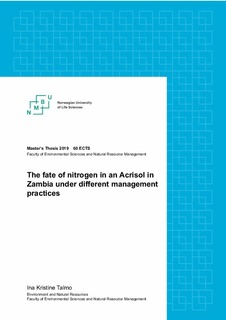| dc.contributor.advisor | Martinsen, Vegard | |
| dc.contributor.advisor | Mulder, Jan | |
| dc.contributor.author | Talmo, Ina Kristine | |
| dc.coverage.spatial | Zambia | nb_NO |
| dc.date.accessioned | 2019-05-10T13:53:56Z | |
| dc.date.available | 2019-05-10T13:53:56Z | |
| dc.date.issued | 2019 | |
| dc.identifier.uri | http://hdl.handle.net/11250/2597286 | |
| dc.description.abstract | A 10-day 15N tracer experiment, using 15N-NO3 and 15N-NH4, was conducted on an Acrisol in Mkushi, Zambia, in a rain-fed maize field. The addition of the 15N label, as either 15N-NO3 or 15N-NH4, was equivalent to 0.1g/m2 with an enrichment of 99.98%, giving no fertilizing effect of the soil. The main objective was to observe how the use of three different management practices; conservation farming (CFN), conservation farming with the addition of 4t biochar/ ha (CFB) and conventional farming (Conv) effected the pathway of nitrogen, especially focusing on the emission of N2O.
The results from the 10-day 15N tracer experiment showed that management practice affected the total N uptake in biomass, N2O fluxes, 15N recovery in N2O and mean %loss of label in the soil pack. CFN was found to have the largest loss of label from the soil profile with a mean % loss of 62%, followed by Conv at 54%, while the smallest loss was found in CFB (36%). In coherence with this, the largest proportional uptake of the 15N-NH4 was in CFN>Conv>CFB, and Conv>CFN>CFB for the 15N-NO3. The differences in N uptake did however not have an effect on yield at harvest. Recovery of the added 15N-label in N2O varied from 0.45 -5.9%. No significant difference between management practice in %loss of the label within the measured system.
A notably large average flux of N2O (221.28 μg N2O-N/m2/h) was measured from the Conv treated plots and was found to positively correlate to soil pH and KCl extractable N (8.14 mg NO3/kg, 22mg NH4/kg), possibly due to residual fertilizer left on the soil surface. N2O fluxes from CFB (53.3 μg N2O-N/m2/h) and CFN (27.7 μg N2O-N/m2/h) were within range of what was found in similar studies. The source of N2O was assessed by examining the relationship between gross nitrification rates with N2O fluxes, expecting a significant positive relationship if the main N2O emitting process was nitrification and by examining the relationship between AT% 15N excess in the N2O and AT% 15N excess in the KCl extractable NO3, expecting to find a significant positive relationship if the main N2O emitting process was denitrification. Neither relationship was found to be significant, the results for main N2O emitting process were therefore inconclusive. | nb_NO |
| dc.description.abstract | Ett 10-dagers 15N tracer eksperiment, tilført som 15N-NO3 eller 15N-NH4, ble gjennomført på en Acrisol i Mkushi, Zambia, på en nedbørsavhengig maisåker. Tilførselen av 15N, som enten 15N-NO3 eller 15N-NH4, tilsvarte en tilførsel av 0.1g/m2 , med en anrikelse på 99.98%, med ingen gjødslingseffekt. Hoved objektivet var å observere hvordan bruken av tre ulike dyrkningssystemer; tradisjonelt jordbruk (Conv), presisjonsjordbruk (CFN) og presisjonsjordbruk med tilførsel av 4 tonn med biokull per hektar (CFB) påvirket tap, tilgjengelighet og opptak av nitrogen, med ett spesielt fokus på tap via N2O utslipp. | nb_NO |
| dc.language.iso | eng | nb_NO |
| dc.publisher | Norwegian University of Life Sciences, Ås | nb_NO |
| dc.rights | Attribution-NonCommercial-NoDerivatives 4.0 Internasjonal | * |
| dc.rights.uri | http://creativecommons.org/licenses/by-nc-nd/4.0/deed.no | * |
| dc.subject | 15N tracer experiment | nb_NO |
| dc.subject | N2O fluxes | nb_NO |
| dc.subject | 15N mass balance | nb_NO |
| dc.title | The fate of nitrogen in an Acrisol in Zambia under different management practices | nb_NO |
| dc.title.alternative | Tap, tilgjengelighet og opptak av nitrogen under ulike dyrkningssystemer i en Acrisol i Zambia | nb_NO |
| dc.type | Master thesis | nb_NO |
| dc.description.version | submittedVersion | nb_NO |
| dc.source.pagenumber | 68 | nb_NO |
| dc.description.localcode | M-MINA | nb_NO |

